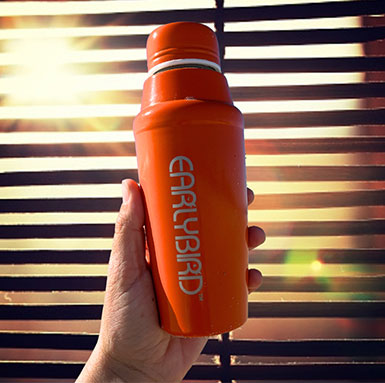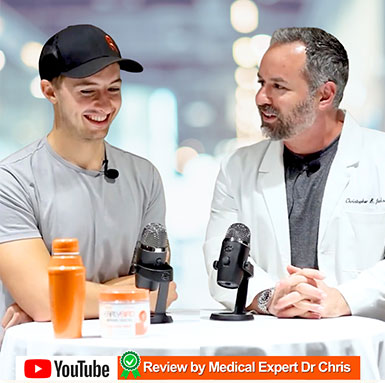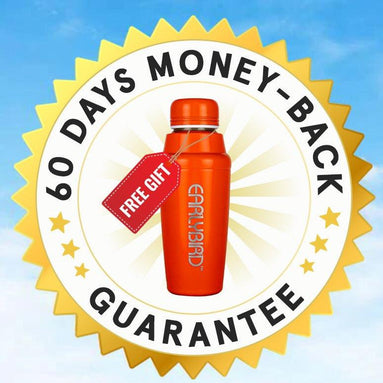Page Content
![]() Health and productivity
Health and productivity
10 Reasons Why US Demand Soars For This Guilt-Free Morning Cocktail!

"EarlyBird hasn’t only solved morning exhaustion, but also solved brain fog and dehydration."
-

By Dr Chris J.
Last Updated
Summary: You can now avoid hitting ‘snooze’ and wake up early without discipline or willpower. Keep reading to discover EarlyBird’s breakthrough health & lifestyle benefits.

1. Makes Waking Up Early Easy
& Fun

Say goodbye to dragging yourself out of bed for your first cup of coffee. EarlyBird’s 13-in-1 healthy blend is made the night before by adding one scoop with water into the EarlyBird cocktail shaker, put on your nightstand before sleep, ready to drink as soon as the alarm goes off. This makes it easy to ignore hitting ‘snooze’ and have energy to wake up early and accomplish more before 8am!

![]() Holly A, Dallas
Holly A, Dallas ![]() Verified Buyer
Verified Buyer
"I’ve never had anything on this planet that does what this does!"

2. Productivity in a Shaker
(included for FREE)

Remember your most productive mornings ever? Those days when you effortlessly tackled all tasks before 8 am? Now, imagine reliving that experience every day for 45, 90, or even 180 days (or more) straight. EarlyBird's natural ingredients make this possible, unlocking instant clean energy, focus, and motivation to help you achieve more each day!

![]() Regina E, Arizona
Regina E, Arizona ![]() Verified Buyer
Verified Buyer
"It’s been 5-days and I’m BLOWN AWAY at my INSANE productivity!"

3. No Sugar, Carbs, Calories,
Dairy or Gluten

You can kickstart your day with wellness and productivity! EarlyBird’s formulation leaves out sugar (for more stable energy), carbs (to prevent blood level spikes), calories (to help with weight loss), dairy & gluten (to avoid inflammation). Perfect for intermittent fasting and fitness minded folk. It helps you start smart and seize the day with more clean energy and focus!

![]() Megan P, Florida
Megan P, Florida ![]() Verified Buyer
Verified Buyer
"I gave it to my Doctor and she looked into it and said GO FOR IT!"

4. Science-backed 3 Secrets
To Waking Up Early

You can enjoy EarlyBirds science-based 3 secrets to waking up early with 1) Clean energy & focus from organic caffeine, L-Tyrosine, L-Theanine, and antioxidants. 2) Supercharge hydration with calcium, sodium, and potassium. And 3) Improved mood & motivation with Nootropics, KSM-66 Ashwagandha, Theobromine, and CoffeeBerry. You can look forward to optimal mornings and productive days. See medical whitepaper here.

![]() Bill C, Tennessee
Bill C, Tennessee ![]() Verified Buyer
Verified Buyer
"I used to be the worlds grumpiest person until my fiance found this!"

5. Humble ‘husband and wife’
founder-story

Innocently researching a solution to conquer their own morning fatigue, Chuckie & Shelby Gregory spent 2 years crafting the perfect formula on their kitchen table. Encouraged by friends and family, they launched EarlyBird in 2019 with just 300 tubs. 2.5 years later they had sold over 1-million tubs and helped transform over 22-million mornings!

![]() Todd K, Arizona
Todd K, Arizona ![]() Verified Buyer
Verified Buyer
"It’s been a lifesaver! I wake up & don’t hit snooze a hundred time!"

6. Delicious flavors even make green, protein or collagen powder taste nice!

You can choose from 3 AMAZING flavors, but also… In addition to enjoying EarlyBird by itself with water, a swarm of EarlyBird customers excitedly share their creative use: turning unpleasant-tasting greens, protein, or collagen powder into a delightful combo drink! Plus, adjusting scoop levels to match your preferred sweetness is an added bonus! *Bonus tip: You can enjoy a wide variety of creative smoothies, shakes and juices with EarlyBird!

![]() Elizabeth G, New Jersey
Elizabeth G, New Jersey ![]() Verified Buyer
Verified Buyer
"It's friken delicious & Fun! I was surprised how quickly it works!"

7. Enjoy Organic Caffeine Without Jitters, Crash or Stomach Issues

Experience a better-then-coffee-like boost without the unwanted side effects! EarlyBird Morning Cocktail combines organic caffeine with antioxidants for clean, jitter-free energy without the crashes and stomach discomfort. Thousands of coffee-lovers switched to EarlyBird or now only drink coffee on social occasions.

![]() Cooper D, San Diego
Cooper D, San Diego ![]() Verified Buyer
Verified Buyer
"All of a sudden, your toes start wiggling and no jitters or CRASH!"

8. Saves money (and time) compared to coffee &
energy drinks!

Forget frequent coffee runs and expensive energy drinks that are short lived and often unhealthy. EarlyBird customers regularly boast how EarlyBird doesn’t cost them money, but saves them money due to the longer lasting clean energy. One EarlyBird can be as low as 0.98c compared to $4.50 starbucks!

![]() Tracey K, Florida
Tracey K, Florida ![]() Verified Buyer
Verified Buyer
"IT WORKS! It’s amazing, it’s not expensive, it’s affordable. TRY IT!"

9. Record-breaking success for
go-getters, moms, dads, nurses
and more!

With an unmatched 4.9 average stars from over 5,000 reviews, EarlyBird is now USA’s #1 Morning Cocktail, selling over 1 million tubs and improving more than 22 million mornings for its 150,000+ happy customers. Featured on Forbes, Fox, NBC, and various television networks, EarlyBird is becoming the FUTURE of waking up early for healthy productive mornings.

![]() Ashleigh D, Nevada
Ashleigh D, Nevada ![]() Verified Buyer
Verified Buyer
"This saved my freaking life as a night shift nurse with flipped schedules!"

10. RISK FREE: Better than
‘Money-Back’ Guarantee

You can now try EarlyBird risk free with a 100% money-back guarantee. However, if you start with their signature ‘Starter Kit’, they insist and DEMAND you keep the shaker for free, even in the unlikely event you don’t enjoy EarlyBird. They also doubled the standard 30-day money back guarantee to a 60-day no question asked guarantee!

![]() Kelly C, Texas
Kelly C, Texas ![]() Verified Buyer
Verified Buyer
"I was so skeptical, but I’ve never reordered something so fast!"

SPECIAL OFFER
GET $147 OF FREE
BONUSES TODAY!
This limited-time deal is in high demand and
in risk of selling out

Offer ends in:
Sell-Out Risk: High
- 60-day money back guarantee
- Keep the shaker either way!
Terms & Conditions | Privacy Policy | Contact Us
Copyright © Club EarlyBird. All Right Reserved.
Medical Research Whitepaper for EarlyBirds Morning Cocktail
Nootropics, Antioxidants, and Hydration for Club EarlyBird
By Dr. Chris, PharmD
Introduction
The EarlyBird Morning Cocktail began as a passion project to produce supercharged hydration, clean energy, and increased motivation. The goal was to identify natural ingredients that could support the heavy workload and stress associated with modern society. They set out to identify compounds that could enhance the ability to maintain attention over extended periods of time and have a profound importance in the everyday life of individuals all over the world where lapses in attention are a common occurrence. That’s where modern science, the concept of nootropics, an understanding of the impact of hydration on cognitive function, and antioxidant support stepped in.
What are Nootropics?
It depends on who you ask. “Nootropic” is the term used to describe “smart drugs”, although most are not considered drugs and do not require a prescription.
There are two generally accepted definitions. The original definition, established by Dr. Corneliu E. Giurgea, a Romanian psychologist and chemist considered to be the founding father of nootropics, and the common definition.1
Dr. Giurgea was the first to attempt a descriptive criterion for what qualifies as a nootropic, which includes:
- Enhancement of memory and learning
- Improved cognition under stress
- Protection of brain cells (e.g., the compound has neuroprotective properties)
- Facilitation of cell-to-cell communication
- Backed by human research demonstrating brain bioactivity
- Absence of usual pharmacological effects (to include side effects) of psychotropic drugs
Meanwhile, the common definition is any compound that boosts productivity, memory formation, and a host of other cognitive functions. That sounds about right for what we’re trying to accomplish with this nootropic stack.
What is a Nootropic Stack?
A “stack” is the term for the combination of two or more nootropics. Most times (but not always), the goal is
synergy. For example, the combination of caffeine in any form and L-theanine is the most basic and common example.
Theanine acts as an anxiolytic (anti-stress compound) to balance out the jittery effects of caffeine, and they are
generally dosed in a 2:1 ratio.
There are various categories that nootropic ingredients can fall into, and some are open for debate. The two that are important for our discussion are: stimulants and adaptogens.
Stimulants
Everyone understands what a stimulant does but maybe not how they do it. Stimulants increase activity in the sympathetic nervous system. The word “stimulant” usually refers to agents stimulating the central nervous system with an effect on alertness, locomotion, and mood. This can elicit the well-known fight-or-flight reaction to increase blood flow to skeletal muscles and mobilize energy. Stimulants can include compounds that increase alertness and reduce fatigue. This means an increase in adrenaline (epinephrine), and dopamine. This group includes ingredients such as Caffeine (and additional forms such as PurCaf®, Infinergy®, and CoffeeBerry®), Theobromine (a metabolite of caffeine), and even those that feed into the nervous system like L-Tyrosine (a building block for adrenaline).
Adaptogens
During World War II, the idea that a pill could improve mental and physical performance in healthy people was devised and various stimulants were given to pilots and members of submarine crews, prior to the formal definition of nootropics. Adaptogens were initially defined by Nikolay Lazarev as substances that enhance the “state of nonspecific resistance” in stress based on Hans Selye’s theory of stress and general adaptation syndrome. Studies on animals and humans support that adaptogens exhibit neuroprotective, anti-fatigue, anxiolytic, and central nervous system stimulating properties. In essence, they combine elements from several of the categories of nootropics. In addition, several clinical trials have demonstrated that adaptogens exert an anti-fatigue effect that increases mental work capacity against the background of stress and fatigue, particularly in tolerance to mental exhaustion and enhanced attention.2 Ashwagandha is one of the most well-known adaptogens in the world today.
Why Hydration Matters
Proper hydration is essential for homeostasis and peak performance, this includes cognition. In a relatively brief period, failure to consume the right amount of water will lead to deteriorating cognition. Adverse effects can present with levels of dehydration at 1.3% body weight loss and may be present when less dehydration is present.3 To be specific, visual sustained attention has shown sensitivity to water consumption. In addition, acute water intervention plays a role in short-term memory, reaction time, and mood.4
Electrolytes such as calcium, potassium, and sodium play vital roles in the body related to many processes and overall hydration levels. Too little calcium can result in confusion and behavior changes and muscle twitching. Too little potassium can result in muscle weakness and cramps, feeling unusually thirsty, and needing to pee frequently. When sodium levels drop, confusion, irritability, weakened reflexes, nausea, and vomiting may be seen.5
In short, proper hydration allows peak performance.
Antioxidants
Oxidative stress from everything from air pollution, cigarette smoke, and modern living, in general, can compromise central nervous system integrity, thereby affecting cognitive ability. Consumption of plant foods or supplements rich in antioxidants could thereby protect cognition. Some of the foods highest in antioxidants are cherries, broccoli, blueberries, turmeric, tea, and coffee. Acute effects are registered within hours of their consumption with chronic benefits appearing after a few weeks of regular intake. These benefits might be more relevant for older adults than younger subjects, but both populations will experience benefits.6
L-Tyrosine7-21
Ingredient Background
L-Tyrosine has been shown to improve mental performance, increase the production of feel-good hormones, and enhance alertness and memory. It is an amino acid found in the diet that is metabolized to produce catecholamines such as dopamine and noradrenaline These are vital for “fight or flight activities”. The main benefits of L-tyrosine are related to its ability to replenish catecholamine levels in the brain, which can become depleted under stressful conditions. Studies have demonstrated that L-tyrosine can help prevent declined cognitive function under stressful, cognitively demanding conditions when supplemented appropriately.
Efficacy/Applications
Memory: L-Tyrosine can increase noradrenaline in the brain and prevent an acute stress-induced reduction of noradrenaline concentrations in rats subject to cold stress. This may also apply to the ability of L-Tyrosine administration to reverse losses of memory induced by cold stress in humans. One study showed that L-Tyrosine taken before cognitive testing in a room where the temperature was reduced from 22°C to 4°C was able to reduce the time taken to answer a delayed Matching-to-Sample test and increase the number of correct answers compared to cold placebo.
Attention: One study in children with diagnosed ADHD given a combination supplement of L-Tyrosine and 5-HTP noted that supplementation was associated with a greater reduction in symptoms as assessed by ADHD-RS.
Wakefulness: One study with supplemental L-Tyrosine was able to attenuate the decrease in cognitive performance that was associated with sleep deprivation.
Stress: Acute and uncontrollable stress can deplete noradrenaline concentrations in neural tissue rapidly. One study in humans subjected to high altitudes has noted protective effects against acute stress due to lessened symptoms of acute stress, where L-tyrosine was associated with less headaches, stress, fatigue, distress, sleepiness, muscular soreness, and coldness due to the acute stressor and noted improvements on global ratings of mood and happiness and cognitive function.
Safety
Overall L-tyrosine appears to be safe and well-tolerated at moderate doses, with one 2-week human trial using a dose of 2500 mg, provided three times per day for two weeks, and another trial using single doses of up to 150 mg/kg of body weight with no adverse effects.
L-Theanine22-44
Ingredient Background
L-Theanine is an amino acid found in tea leaves that promotes smooth energy and intense focus, all day long. The main benefits of L-Theanine are associated with promoting a relaxed state without drowsiness. L-theanine may also have mild cognitive-enhancing effects, especially when taken with caffeine, typically in a 2:1 combination, which also helps with caffeine-induced jitters. L-Theanine has also been shown to suppress the blood pressure-increasing effects of caffeine (although, there are limits to this) and may also counteract blood pressure increases under stressful conditions.
Efficacy/Applications
L-Theanine supplementation has been repeatedly noted to increase α-waves during closed eye rest as well as during visuospatial tasks around 30-45 minutes after ingestion. α-waves are associated with a state of relaxation. Beyond relaxation, increased α-waves are associated with selective attention mechanisms and alertness. These altered wave functions are said the be evidence that theanine has to relax and attention-promoting properties.
Attention/ADHD: In persons with mild cognitive impairment, a combination supplement of green tea extract and theanine over 16 weeks was able to improve selective attention as assessed by a Stroop test.
Stress: Supplementation of L-Theanine prior to an arithmetic stress test has been noted to reduce perceived stress following the task and to attenuate the risk in salivary IgA concentrations, which is a biomarker of stress, by approximately half at the conclusion of the task.
With Caffeine: In comparison to 50mg caffeine in isolation, the addition of 100mg of L-Theanine to the caffeine was able to positively influence parameters of accuracy and attention when it came to cognitive testing.
Safety
L-Theanine is generally recognized as safe and has a long history of use. L-Theanine is metabolized in the kidneys via the phosphate-independent variant of the enzyme glutaminase and is not affected by the phosphate-dependent version, a similar metabolism as glutamine. It has been reported that that oral ingestion of 99% L-Theanine has failed to produce toxicity in rats at either 6,500mg/kg for 2 weeks or 2,000mg/kg over 28 days. 5% of the diet as L-theanine for 78 weeks has also failed to produce toxic effects. A 13-week toxicity test in rats has established a No Observable Adverse Effect Limit (NOAEL) of 4,000mg/kg body weight, which was the highest dose tested.
Turmeric45-54
Ingredient Background
Curcumin is a yellow pigment found primarily in turmeric, which is a flowering plant of the ginger family best known as a spice. It is a polyphenol with anti-inflammatory properties and the ability to increase the number of antioxidants that the body produces. Curcumin and the curcuminoids found in turmeric can be extracted to produce supplements that have a much higher potency than turmeric alone. Curcumin is absorbed poorly during digestion. Different formulations have been created to improve its bioavailability, including pairing it with black pepper (BioPerine).
Efficacy/Applications
Depression: Curcumin has been shown to be a potent anti-depressant in animal models of depression. It exerts these effects via anti-oxidation in the brain and attenuation of neuroinflammation. A recent randomized, double-blinded, placebo-controlled trial investigated whether curcumin was more effective than placebo at reducing symptoms of depression. The study found that curcumin was more effective than placebo in reducing symptoms of depression and this difference was statistically significant.
Safety
Turmeric is generally recognized as safe and has a long history of traditional use. Curcumin inherently exhibits low bioactivity in part due to its low intestinal absorption rate and in part due to rapid metabolism, glucuronidation.
BioPerine (Piper nigrum)55-57
Ingredient Background
Black Pepper is a spice commonly used in many areas of the world for flavor. Through its active component Piperine, Black Pepper can modify supplement and drug metabolism. It is an antioxidant-dense superfood shown to improve memory and make many ingredients more bioavailable (e.g., you absorb more turmeric when combined with black pepper). A process in the liver called glucuronidation, which attaches a molecule (glucuronide) to drugs to signal for their urinary excretion, is inhibited with Piperine.
Efficacy/Applications
Enterohepatic Effects: Piperine is known for changing the metabolism of various drugs and supplements, most notably increasing curcumin bioavailability by 2000%. It impacts metabolism by both intestinal absorption as well as downregulating or inhibiting phase II detoxification enzymes and the glucuronidation process in the liver. It may also contribute to increasing absorption by slowing the intestinal transit rate and prolonging the time each compound is exposed to the potential uptake.
Safety
Black pepper is considered safe and has a long history of use.
KSM-66 Ashwagandha58-71
Ingredient Background
Ashwagandha (Withania somnifera), also known as Indian Ginseng, is an herb used in Ayurveda, the traditional medicine of India, and has been called “the king of Ayurvedic herbs”. The most potent form of Ashwagandha available is KSM-66. Ashwagandha is best known for its anxiolytic and stress-relieving effects. It also reduces cortisol levels, a claim supported by many studies. In addition, a growing body of evidence supports the efficacy of ashwagandha for improving total sleep time and sleep quality in people with and without insomnia.
There is also increasing interest in ashwagandha among athletes. Ashwagandha has been reported to improve VO2max, and preliminary evidence suggests that it improves upper and lower body strength, lower body power, and recovery.
Efficacy/Applications
Ashwagandha contains numerous bioactive compounds, namely alkaloids, flavonoids, glycosides, steroids, and steroidal lactones. Within the steroidal lactones are withanolides, which are responsible for most of the plant’s benefits. Most of ashwagandha’s benefits are at least partly due to its potent antioxidant and anti-inflammatory properties. Ashwagandha can increase levels of antioxidant enzymes like glutathione peroxidase and superoxide dismutase, while also inhibiting lipid peroxidation.
As part of its ability to reduce stress and anxiety, ashwagandha also appears to influence the hypothalamic-pituitary-adrenal axis, which plays a central role in the stress response. This is supported by its ability to decrease cortisol levels. Ashwagandha seems to alter the signaling of several neurotransmitters as well. In particular, ones that are dysfunctional in anxiety disorders. Its ability to enhance GABAA receptor signaling, specifically, is thought to underlie its benefits for sleep.
Ashwagandha may improve endurance performance by increasing levels of hemoglobin, the protein in red blood cells responsible for transporting oxygen to the rest of the body. Studies are currently underway.
Safety
KSM-66 is the most studied form of ashwagandha and has multiple human trials on safety and efficacy.
Blueberry Powder72-83
Ingredient Background
Blueberries have a potential nootropic effect. They have been found to improve cognition in people undergoing cognitive decline. In addition, there is also some rodent evidence that suggests blueberries can improve cognition in healthy young people as well. They may also have a role to play in promoting the growth of nervous tissue and reducing neurological inflammation.
Efficacy/Applications
Neuroinflammation: In vitro, blueberries have shown anti-inflammatory effects via reducing the release of inflammatory biomarkers which respond to inflammatory signals and contribute to some pathological conditions of cognitive decline.
Neurogenesis: Blueberry ingestion has been noted to augment a kainic acid induced increase in IGF-1 over several weeks. Dietary supplementation of blueberry has been observed to increase brain BDNF levels.
Memory and Learning: In twelve elderly humans with age-related memory decline, concord grape juice (containing anthocyanin from blueberries) daily for 12 weeks was associated with an improvement of verbal learning and benefits in spatial and verbal recall and a later study using similar dosing in a similar population found cognitive benefit with wild blueberry juice as assessed by verbal memory tests.
Safety
Blueberries are generally recognized as safe with a long history of use. Anthocyanins appear to undergo slightly degradation in saliva which appears to be mediated by salivary bacteria. The bioavailability of anthocyanins tends to be in the range of 1.7-3.3%. Anthocyanins have been confirmed to be absorbed from the intestines. Blueberry consumption has also been confirmed to be a bioavailable source of Quercetin.
Green Tea Extract84-96
Ingredient Background
Green tea (Camellia Sinensis) is a plant frequently steeped in hot water and drunk as tea. It exerts most of its benefits through water-soluble polyphenols (frequently referred to as catechins) extracted from the leaves, into water, which is then consumed. It has been studied for benefits in almost every organ system in the body. It is cardioprotective, neuroprotective, anti-obesity, anti-carcinogenic, anti-diabetic, anti-atherogenic, liver protective and beneficial for blood vessel health.
About 30% of the leaves by weight are either favonols or flavanols, the latter of which is comprised mostly of compounds called catechins. These catechins are then broken down into four main classifications of: epigallocatechin-3-gallate (EGCG), epi-gallocatechin (EGC), epicatechin gallate (ECG) and epicatechin (EC). Although all catechins share similar properties, EGCG appears to be most potent.
Most doses are standardized against EGCG. Although the amount of EGCG-equivalent varies from one cup of tea to another, depending on many factors such as the species of tea, length of steeping, and time spent oxidizing. One cup of Camellia sinensis green tea contains approximately 50mg of EGCG-equivalent.
Efficacy/Applications
Learning and Memory: Due to EGCG being able to easily cross the blood brain barrier and increasing brain activity up to 2 hours after ingestion, biological importance regarding cognition has been investigated. Mechanistically, EGCG has been shown to augment proliferation of adult neural progenitor cells in vitro. An additional mechanism may be acetylcholinesterase inhibition, as less activity was noted in the brains of aged rats fed green tea catechins.
Anxiety and Mood: Regarding anxiety, the primary catechin (EGCG) has been shown in vitro to negate negative modulation of GABA receptors, and in vivo has reduced anxiety in rats.
Skin/Acne: Green tea is thought to help with acne due to not only its anti-inflammatory effects but also by being implicated in reducing sebum production and overgrowth of a bacteria known as Propionibacterium acnes; both of which are heavily involved in the production of acne. The inhibition of P. acnes by EGCG appears to increase in a concentration-dependent and appears to reduce P. acnes-induced inflammation as assessed by IL-8 production and TLR2 expression in monocytes. When Green Tea Catechins are taken orally by adult women with acne for four weeks supplementation appears to be associated with reduced acne overall when the subjects were compared to themselves four weeks prior.
Safety
Green tea extract is generally recognized as safe. Green tea catechins Epicatechin and Epigallocatechin are excreted in the urine, as their serum conjugates are water soluble. EGCG does not appear to be excreted in the urine.
Coffee / Caffeine / Theobromine97-123
Ingredient Background
PurCaf
Non-GMO, sustainably grown, and ethically farmed form of caffeine extracted from green coffee beans gives you a quick mental jumpstart that lasts.
Infinergy (Dicaffeine malate)
Non-GMO, sustainably grown, and ethically farmed form of caffeine extracted from green coffee beans gives you a quick mental jumpstart that lasts. This form is for a smoother release resulting in less jitters.
CoffeeBerry (Coffea arabica extract)
This patented coffee-berry provides 307% better focus and enhanced mood than coffee alone.
Theobromine
Alkaloid found in chocolate! Giving a longer-lasting energy boost than caffeine and a fuzzy feel-good feeling without any sugar or caffeine crash. Theobromine is a metabolite of caffeine and is also made naturally in the body following the ingestion of caffeine.
Caffeine
Caffeine is the most prolifically utilized psychoactive agent worldwide. At least 80% of adults in westernized nations rely on caffeine to keep up with the demands of modern life. That percentage increases to 85% in the United States, where median use in adults aged 50-64 was 226mg/day as reported in a 2014 study by Food and Chemical Toxicology.
Caffeine is a naturally occurring methylxanthine compound found in the leaves, seeds, or fruits of various plants, including coffee (Coffea arabica) beans, cacao (Theobroma cacao) beans, guarana (Paullinia cupana) berries, tea (Camellia sinensis) leaves—in total, over 60 plant species.
Caffeine is a powerful stimulant, and it can be used to improve physical strength and endurance. It is classified as a nootropic because it sensitizes neurons and provides mental stimulation. Habitual caffeine use is also associated with a reduced risk of Alzheimer's disease, cirrhosis, and liver cancer.
Efficacy/Applications
The primary mechanism of action of caffeine is adenosine antagonism. By blocking adenosine receptors, caffeine can reverse the depressive effects of adenosine on the nervous system. Adenosine receptors are upregulated by 20% in response to chronic caffeine intake. Caffeine can also increase the amount of adrenaline and noradrenaline in your system as well as increase dopamine levels. Increases in these neurotransmitters, referred to as catecholamines, have multiple effects throughout the body and affect several performance variables, such as accuracy, reaction time, and global vigilance. Increases in adrenaline appear to be independent of the adenosine receptors and instead are mediated by adrenergic receptors. Acutely, caffeine ingestion increases adrenaline and noradrenaline levels in the body of persons who consume it. This increase seems to be fairly dose dependent. Chronic caffeine ingestion can downregulate (reduce) the number of beta-adrenergic receptors in the brain by up to 25% in some areas.
Trials on non-human mammals have implied a neuroprotective effect from caffeine when experimenters attempted to
induce neurotoxicity. A pro-cholinergic pathway has been suggested as well to improve cognition after caffeine was
able to stave off both short-term and long-term memory loss in the presence of the anticholinergic drug scopolamine
in mice. While these applications in animals help to characterize caffeine as a nootropic, note that trials
intentionally inflicting harm on subjects would be unethical, and thus impossible if posed on human subjects. This
is the case for many of the trials conducted in rats or mice throughout this paper.
Caffeine promotes wakefulness and strengthens mental alertness. It may be particularly efficacious in non-users and
improve reaction time after sleep deprivation. The stimulant has been found to reduce omission and commission
errors; these findings were observed in conjunction with reduced tonic alpha-band activity, suggesting improved
attentional processing.
Safety
Caffeine is generally recognized as safe with a long history of use. The widely used methylxanthine is rapidly absorbed, oral bioavailability is essentially 100%, it crosses the blood brain barrier, and it reaches peak concentration 15-120 minutes after oral ingestion depending on age and fed/unfed state. Per the US Dietary Guidelines Advisory Committee, daily intake of caffeine should not exceed 400mg/day in healthy adults and is proven not to contribute to major chronic diseases at such doses. Due to the potential for caffeine to increase catecholamines such as epinephrine, doses exceeding 400mg/day can lead to insomnia, tachyarrhythmias, and increased blood pressure via vasoconstriction. Caffeine can be metabolized into dimethylxanthine derivatives such as theobromine. The half-life of caffeine varies widely with one study noted a range of 2.7-9.9 hours.
Broccoli124-134
Ingredient Background
The sprouting broccoli is thought to originally come from the eastern Mediterranean area and to be introduced to Europe in the medieval times. Prominent components of broccoli are glucosinolates (b-thioglucoside N-hydroxy-sulfates) which are present in all members of the Brassicaceae family.
Efficacy/Applications
Broccoli is a potent antioxidant and contains sulforaphane, a sulfur-rich compound with many health benefits. Hydrogen sulfide is one of three major gasotransmitters in the human body, transmitting molecules which happen to be gasses, alongside nitric oxide, and carbon monoxide, and is the major underlying factor in garlic supplementation. Cruciferous vegetables are known to confer a smell of hydrogen sulfide when cooked.
Antioxidant Effects: Determination of antioxidant capacity of extracts deriving from various broccoli cultivars revealed that hydrophilic extracts (the ones prevalent in water) are much more active against reactive oxygen species than lipophilic extracts. The defense mechanisms of cells against reactive oxygen species consist of various enzymatic activities like those of superoxide dismutase, catalase, and glutathione peroxidase. Oxidized glutathione is reduced by the enzyme glutathione reductase. After feeding rats with broccoli less oxidative stress was observed compared to controls.
Nerve Cells: Incubation of nerve cells with sulforaphane appears to be able to offer oxidative protection from high glucose concentrations.
Anti-Aging: Mechanisms of Sulforaphane related to anti-aging appear to be centralized around inducing the Proteasome activity and reducing cellular build-up of modified proteins; a reduction in the activity of this system induces cellular aging (senescence).
Safety
Broccoli and its components are generally recognized as safe with a long history of use. Sulforaphane appears to be well absorbed, as numerous studies in humans following the consumption of broccoli have noted increased urinary metabolites of Sulforaphane. In humans, bioavailability of sulforaphane appears to be 74% and primarily absorbed in the jejunum.
Tart Cherry135-141
Ingredient Background
Tart cherries have become increasingly popular over the last couple of years. Tart cherry juice is made from the fruit of the Prunus cerasus tree, native to southwest Asia and Europe, and is linked to several interesting health benefits.
Efficacy/Applications
Tart cherry contains active compounds, including polyphenols that may contribute to its antioxidant and anti-inflammatory effects. Inflammatory signaling pathways regulate the recruitment of inflammatory cells important for the pathogenesis of disease.
Pain: A study was conducted to determine the effects of tart cherry on neuropathic pain in non-diabetic peripheral polyneuropathies. This is a common condition that typically affects individuals aged 50 years and over and can develop from injury to nerve tissue, nerve compression, or autoimmune attacks. The study included 12 patients with painful lower extremity peripheral neuropathy. The participants described their pain as 9–10 out of 10 more than half of the time. The results showed that more than half of the participants had a 50% or greater reduction in maximum pain.
Cognition: Researchers measured the effect of TC concentrate on memory and cognitive performance in older adults aged 65–80 years. This study demonstrated that the daily intake of tart cherry by older adults may help to improve subjective memory and cognitive abilities in older adults, as evidenced by increased contentment with memory, improved visual sustained attention and spatial working memory, and reduced movement time and total errors made on learning new tasks.
Safety
Tart cherry is generally recognized as safe and is widely used in beverages and supplements alike.
Electrolytes (Sodium Chloride / Calcium Citrate /
Potassium Chloride)3-4
Ingredient Background
Sodium, potassium, and calcium are vital to several processes that keep us alive, and they play an incredible role in hydration. It has been suggested that decrements in cognitive performance are present in the range of a 2 to 3% reduction in body weight, several dose-response studies indicate dehydration levels of 1% may adversely affect cognitive performance. When a 2% or more reduction in body weight is induced by heat and exercise exposure, decrements in visual-motor tracking, short-term memory and attention are reported.
Efficacy/Applications
Fluid balance within the body is maintained via homeostatic mechanisms; water conservation occurs via the renal system, modifying urine production. Water intake is encouraged by thirst sensation. Although these mechanisms are intrinsic in homeostatic maintenance, they are also fallible, particularly in vulnerable groups such as older adults who maintain their hydration state inadequately. Older adults are also more likely to have reduced kidney filtration function, resulting in less efficient water conservation when dehydrated, further exacerbating difficulties in recognizing a dehydrated state. This doesn’t only apply to the elderly though.
Investigations into dehydration and mental performance were first systematically carried out in a military population. Soldiers were exposed to extreme heat, inducing varying severities of dehydration. Cognitive abilities such as short-term memory, numerical ability, psychomotor function, and sustained attention were assessed to establish any deficits because of changes in hydration status. Cognitive deficits were dependent on the severity of dehydration, which affected performance in all cognitive tasks when soldiers were in a severe state of dehydration (0.2 % body mass loss). This study was the first to emphasize that cognitive abilities were sensitive to a suboptimal hydration state. Subsequent studies both in a military population and in the general population supported this initial evidence of detriments in cognitive abilities with induced dehydration.
Studies measuring self-reported changes in mental state have consistently found associations between dehydration and mood, in conjunction with changes in performance or with limited to no performance changes. Despite variability in rating methods used, similar mood states were reported such as less alertness, difficulty in concentrating, and fatigue. Some studies also reported that participants found completing the experimental tasks more difficult when in a dehydrated state. These findings highlight that self-reported mood states are sensitive to changes in hydration state and can occur independently from any cognitive performance changes.
The homeostatic responses to dehydration can impact several systems. Key hormones such as angiotensin II involved in the homeostatic response of fluid imbalance come into play. One possible mechanism, proposed by researchers is that cognitive deficits during dehydration could be increased levels of cortisol, often released during a stress response. It has been shown that higher levels of cortisol can lower memory function and processing speed and consequently cause memory-related cognitive deficits. Other neurotransmitter systems have been shown to act differently because of dehydration, potentially mediating the cognitive deficits reported. Serotonergic and dopaminergic systems modify blood–brain barrier permeability, which, if sustained, causes central nervous system dysfunction. Findings also indicate that d-aminobutyric acid and glutamate levels increase during chronic dehydration, influencing both inhibitory and excitatory activities of the brain.
With all of that said, the ingestion of an appropriate amount of electrolytes daily can help to minimize the cognitive impact of dehydration.
Safety
Sodium, potassium, and calcium are safe at appropriate levels.
Conclusion:
Targeting hydration in cognition enhancing supplements is a novel method of achieving the desired end state and a major differentiator in the EarlyBird product. What could have been three separate products (hydration therapy, cognitive enhancement, mood stabilizer) has been combined into a single product that will truly benefit the end user. All ingredients have a functional role in the product and no avoidable fillers have been utilized.
*Disclaimer:
The information contained in this document is a review of publicly available data and does not constitute claims made regarding any commercially available product nor qualified health benefits with the FDA.
References
- Giurgea C. Vers une pharmacologie de l'activité intégrative du cerveau. Pharmacology of integrative activity of the brain. Attempt at nootropic concept in psychopharmacology. Actual Pharmacol (Paris). 1972;25:115-56. French. PMID: 4541214.
- Panossian, Alexander, and Georg Wikman. “Effects of Adaptogens on the Central Nervous System and the Molecular Mechanisms Associated with Their Stress—Protective Activity.” Pharmaceuticals, vol. 3, no. 1, 2010, pp. 188–224., doi:10.3390/ph3010188.
- Harris R. Lieberman (2007) Hydration and Cognition: A Critical Review and Recommendations for Future Research, Journal of the American College of Nutrition, 26:sup5, 555S-561S, DOI: 10.1080/07315724.2007.10719658
- Masento, Natalie A., et al. “Effects of Hydration Status on Cognitive Performance and Mood.” British Journal of Nutrition, vol. 111, no. 10, 2014, pp. 1841–1852., https://doi.org/10.1017/s0007114513004455.
- “Electrolytes: Types, Purpose and Normal Levels.” Cleveland Clinic, https://my.clevelandclinic.org/health/diagnostics/21790-electrolytes.
- Baroni, L.; Sarni, A.R.;Zuliani, C. Plant Foods Rich in Antioxidants and Human Cognition: A Systematic Review. Antioxidants 2021, 10, 714. https://doi.org/10.3390/antiox10050714
- Jongkees BJ, Hommel B, Kühn S, Colzato LSEffect of tyrosine supplementation on clinical and healthy populations under stress or cognitive demands--A reviewJ Psychiatr Res.(2015 Nov)
- M J Sole, C R Benedict, M G Myers, F H Leenen, G H AndersonChronic dietary tyrosine supplements do not affect mild essential hypertensionHypertension.(Jul-Aug 1985)
- Ondine van de Rest, Mirjam Bloemendaal, Rianne de Heus, Esther AartsDose-Dependent Effects of Oral Tyrosine Administration on Plasma Tyrosine Levels and Cognition in AgingNutrients.(2017 Nov 23)
- Glaeser BS, Melamed E, Growdon JH, Wurtman RJElevation of plasma tyrosine after a single oral dose of L-tyrosineLife Sci.(1979 Jul 16)
- S KAUFMAN, S FRIEDMANDOPAMINE-BETA-HYDROXYLASEPharmacol Rev.(1965 Jun)
- Shurtleff D, Thomas JR, Schrot J, Kowalski K, Harford RTyrosine reverses a cold-induced working memory deficit in humansPharmacol Biochem Behav.(1994 Apr)
- Yeghiayan SK, Luo S, Shukitt-Hale B, Lieberman HRTyrosine improves behavioral and neurochemical deficits caused by cold exposurePhysiol Behav.(2001 Feb)
- Treatment of attention deficit hyperactivity disorder with monoamine amino acid precursors and organic cation transporter assay interpretation.
- Neri DF, Wiegmann D, Stanny RR, Shappell SA, McCardie A, McKay DLThe effects of tyrosine on cognitive performance during extended wakefulnessAviat Space Environ Med.(1995 Apr)
- Lehnert H, Reinstein DK, Strowbridge BW, Wurtman RJNeurochemical and behavioral consequences of acute, uncontrollable stress: effects of dietary tyrosineBrain Res.(1984 Jun 15)
- Irwin J, Suissa A, Anisman HDifferential effects of inescapable shock on escape performance and discrimination learning in a water escape taskJ Exp Psychol Anim Behav Process.(1980 Jan)
- Brady K, Brown JW, Thurmond JBBehavioral and neurochemical effects of dietary tyrosine in young and aged mice following cold-swim stressPharmacol Biochem Behav.(1980 May)
- Tyrosine Pretreatment Reverses HypothermiaInduced Behavioral Depression.
- Tyrosine and Stress: Human and Animal Studies.
- Banderet LE, Lieberman HRTreatment with tyrosine, a neurotransmitter precursor, reduces environmental stress in humansBrain Res Bull.(1989 Apr)
- Gail N Owen, Holly Parnell, Eveline A De Bruin, Jane A RycroftThe combined effects of L-theanine and caffeine on cognitive performance and moodNutr Neurosci.(2008 Aug)
- Peter J Rogers, Jessica E Smith, Susan V Heatherley, C W Pleydell-PearceTime for tea: mood, blood pressure and cognitive performance effects of caffeine and theanine administered alone and togetherPsychopharmacology (Berl).(2008 Jan)
- Ai Yoto, Mao Motoki, Sato Murao, Hidehiko YokogoshiEffects of L-theanine or caffeine intake on changes in blood pressure under physical and psychological stressesJ Physiol Anthropol.(2012 Oct 29)
- Theertham P Rao, Motoko Ozeki, Lekh R JunejaIn Search of a Safe Natural Sleep AidJ Am Coll Nutr.(2015)
- T Terashima, J Takido, H YokogoshiTime-dependent changes of amino acids in the serum, liver, brain and urine of rats administered with theanineBiosci Biotechnol Biochem.(1999 Apr)
- Manuel Gomez-Ramirez, Beth A Higgins, Jane A Rycroft, Gail N Owen, Jeannette Mahoney, Marina Shpaner, John J FoxeThe deployment of intersensory selective attention: a high-density electrical mapping study of the effects of theanineClin Neuropharmacol.(Jan-Feb 2007)
- Shinsuke Hidese, Shintaro Ogawa, Miho Ota, Ikki Ishida, Zenta Yasukawa, Makoto Ozeki, Hiroshi KunugiEffects of L-Theanine Administration on Stress-Related Symptoms and Cognitive Functions in Healthy Adults: A Randomized Controlled TrialNutrients.(2019 Oct 3)
- Nobre AC, Rao A, Owen GNL-theanine, a natural constituent in tea, and its effect on mental stateAsia Pac J Clin Nutr.(2008)
- L-theanine—a unique amino acid of green tea and its relaxation effect in humans.
- Suntheanine: A pure and safe L-theanine dietary supplement for relaxation and stress relief.
- Kimura K, Ozeki M, Juneja LR, Ohira HL-Theanine reduces psychological and physiological stress responsesBiol Psychol.(2007 Jan)
- Gomez-Ramirez M, Kelly SP, Montesi JL, Foxe JJThe effects of L-theanine on alpha-band oscillatory brain activity during a visuo-spatial attention taskBrain Topogr.(2009 Jun)
- Park SK, Jung IC, Lee WK, Lee YS, Park HK, Go HJ, Kim K, Lim NK, Hong JT, Ly SY, Rho SSA combination of green tea extract and l-theanine improves memory and attention in subjects with mild cognitive impairment: a double-blind placebo-controlled studyJ Med Food.(2011 Apr)
- Tsuge H, Sano S, Hayakawa T, Kakuda T, Unno TTheanine, gamma-glutamylethylamide, is metabolized by renal phosphate-independent glutaminaseBiochim Biophys Acta.(2003 Mar 17)
- Pfurtscheller GEvent-related synchronization (ERS): an electrophysiological correlate of cortical areas at restElectroencephalogr Clin Neurophysiol.(1992 Jul)
- Gomez-Ramirez M, Higgins BA, Rycroft JA, Owen GN, Mahoney J, Shpaner M, Foxe JJThe deployment of intersensory selective attention: a high-density electrical mapping study of the effects of theanineClin Neuropharmacol.(2007 Jan-Feb)
- Visual spatial attention tracking using high-density SSVEP data for independent brain-computer communication.
- Kelly SP, Lalor EC, Reilly RB, Foxe JJIncreases in alpha oscillatory power reflect an active retinotopic mechanism for distracter suppression during sustained visuospatial attentionJ Neurophysiol.(2006 Jun)
- Klimesch W, Doppelmayr M, Russegger H, Pachinger T, Schwaiger JInduced alpha band power changes in the human EEG and attentionNeurosci Lett.(1998 Mar 13)
- Owen GN, Parnell H, De Bruin EA, Rycroft JAThe combined effects of L-theanine and caffeine on cognitive performance and moodNutr Neurosci.(2008 Aug)
- Giesbrecht T, Rycroft JA, Rowson MJ, De Bruin EAThe combination of L-theanine and caffeine improves cognitive performance and increases subjective alertnessNutr Neurosci.(2010 Dec)
- Foxe JJ, Morie KP, Laud PJ, Rowson MJ, de Bruin EA, Kelly SPAssessing the effects of caffeine and theanine on the maintenance of vigilance during a sustained attention taskNeuropharmacology.(2012 Jun)
- Borzelleca JF, Peters D, Hall WA 13-week dietary toxicity and toxicokinetic study with l-theanine in ratsFood Chem Toxicol.(2006 Jul)
- P1, Kunnumakkara AB, Newman RA, Aggarwal BBBioavailability of curcumin: problems and promisesMol Pharm.(2007 Nov-Dec)
- Garcea G, Berry DP, Jones DJ, Singh R, Dennison AR, Farmer PB, Sharma RA, Steward WP, Gescher AJConsumption of the putative chemopreventive agent curcumin by cancer patients: assessment of curcumin levels in the colorectum and their pharmacodynamic consequencesCancer Epidemiol Biomarkers Prev.(2005 Jan)
- Ireson C, Orr S, Jones DJ, Verschoyle R, Lim CK, Luo JL, Howells L, Plummer S, Jukes R, Williams M, Steward WP, Gescher ACharacterization of metabolites of the chemopreventive agent curcumin in human and rat hepatocytes and in the rat in vivo, and evaluation of their ability to inhibit phorbol ester-induced prostaglandin E2 production Cancer Res.(2001 Feb 1)
- Vareed SK, Kakarala M, Ruffin MT, Crowell JA, Normolle DP, Djuric Z, Brenner DEPharmacokinetics of curcumin conjugate metabolites in healthy human subjectsCancer Epidemiol Biomarkers Prev.(2008 Jun)
- Lopresti AL, Hood SD, Drummond PDMultiple antidepressant potential modes of action of curcumin: a review of its anti-inflammatory, monoaminergic, antioxidant, immune-modulating and neuroprotective effectsJ Psychopharmacol.(2012 Dec)
- Sanmukhani J, Satodia V, Trivedi J, Patel T, Tiwari D, Panchal B, Goel A, Tripathi CBEfficacy and safety of curcumin in major depressive disorder: a randomized controlled trialPhytother Res.(2014 Apr)
- Bergman J, Miodownik C, Bersudsky Y, Sokolik S, Lerner PP, Kreinin A, Polakiewicz J, Lerner VCurcumin as an add-on to antidepressive treatment: a randomized, double-blind, placebo-controlled, pilot clinical studyClin Neuropharmacol.(2013 May-Jun)
- Lopresti AL, Maes M, Maker GL, Hood SD, Drummond PDCurcumin for the treatment of major depression: a randomised, double-blind, placebo controlled studyJ Affect Disord.(2014)
- Panahi Y, Badeli R, Karami GR, Sahebkar AInvestigation of the efficacy of adjunctive therapy with bioavailability-boosted curcuminoids in major depressive disorderPhytother Res.(2015 Jan)
- Lopresti AL, Drummond PDEfficacy of curcumin, and a saffron/curcumin combination for the treatment of major depression: A randomised, double-blind, placebo-controlled studyJ Affect Disord.(2017 Jan 1)
- Shoba G, Joy D, Joseph T, Majeed M, Rajendran R, Srinivas PSInfluence of piperine on the pharmacokinetics of curcumin in animals and human volunteersPlanta Med.(1998 May)
- Han HKThe effects of black pepper on the intestinal absorption and hepatic metabolism of drugsExpert Opin Drug Metab Toxicol.(2011 Jun)
- Bajad S, Bedi KL, Singla AK, Johri RKPiperine inhibits gastric emptying and gastrointestinal transit in rats and micePlanta Med.(2001 Mar)
- Pratte MA, Nanavati KB, Young V, Morley CPAn alternative treatment for anxiety: a systematic review of human trial results reported for the Ayurvedic herb ashwagandha (Withania somnifera)J Altern Complement Med.(2014 Dec)
- Sara Fuladi, Seyed Ahmad Emami, Amir Hooshang Mohammadpour, Asieh Karimani, Ali Akhondpour Manteghi, Amirhossein SahebkarAssessment of Withania Somnifera Root Extract Efficacy in Patients With Generalized Anxiety Disorder: A Randomized Double-Blind Placebo-Controlled TrialCurr Clin Pharmacol.(2020 Apr 13)
- Lopresti AL, Smith SJ, Malvi H, Kodgule RAn investigation into the stress-relieving and pharmacological actions of an ashwagandha (Withania somnifera) extract: A randomized, double-blind, placebo-controlled studyMedicine (Baltimore).(2019 Sep)
- Kumarpillai Gopukumar, Shefali Thanawala, Venkateswarlu Somepalli, T S Sathyanaryana Rao, Vijaya Bhaskar Thamatam, Sanjaya ChauhanEfficacy and Safety of Ashwagandha Root Extract on Cognitive Functions in Healthy, Stressed Adults: A Randomized, Double-Blind, Placebo-Controlled StudyEvid Based Complement Alternat Med.(2021 Nov 30)
- Salve J, Pate S, Debnath K, Langade DAdaptogenic and Anxiolytic Effects of Ashwagandha Root Extract in Healthy Adults: A Double-blind, Randomized, Placebo-controlled Clinical StudyCureus.(2019 Dec 25)
- K Chandrasekhar, Jyoti Kapoor, Sridhar AnishettyA prospective, randomized double-blind, placebo-controlled study of safety and efficacy of a high-concentration full-spectrum extract of ashwagandha root in reducing stress and anxiety in adultsIndian J Psychol Med.(2012 Jul)
- Choudhary D, Bhattacharyya S, Joshi KBody Weight Management in Adults Under Chronic Stress Through Treatment With Ashwagandha Root Extract: A Double-Blind, Randomized, Placebo-Controlled TrialJ Evid Based Complementary Altern Med.(2017 Jan)
- A Remenapp, K Coyle, T Orange, T Lynch, D Hooper, S Hooper, K Conway, H A HausenblasEfficacy of Withania somnifera supplementation on adult's cognition and moodJ Ayurveda Integr Med.(2021 Nov 25)
- Kae Ling Cheah, Mohd Noor Norhayati, Lili Husniati Yaacob, Razlina Abdul RahmanEffect of Ashwagandha (Withania somnifera) extract on sleep: A systematic review and meta-analysisPLoS One.(2021 Sep 24)
- Diego A Bonilla, Yurany Moreno, Camila Gho, Jorge L Petro, Adrián Odriozola-Martínez, Richard B KreiderEffects of Ashwagandha ( Withania somnifera) on Physical Performance: Systematic Review and Bayesian Meta-AnalysisJ Funct Morphol Kinesiol.(2021 Feb 11)
- Ziegenfuss TN, Kedia AW, Sandrock JE, Raub BJ, Kerksick CM, Lopez HLEffects of an Aqueous Extract of Withania somnifera on Strength Training Adaptations and Recovery: The STAR TrialNutrients.(2018 Nov 20)
- Sandhu JS, Shah B, Shenoy S, Chauhan S, Lavekar GS, Padhi MMEffects of Withania somnifera (Ashwagandha) and Terminalia arjuna (Arjuna) on physical performance and cardiorespiratory endurance in healthy young adultsInt J Ayurveda Res.(2010 Jul)
- Shashank Tiwari, Sandeep Kumar Gupta, Anklesh Kumar PathakA double-blind, randomized, placebo-controlled trial on the effect of Ashwagandha (Withania somnifera dunal.) root extract in improving cardiorespiratory endurance and recovery in healthy athletic adultsJ Ethnopharmacol.(2021 May 23)
- Adrian L Lopresti, Stephen J Smith, Peter D DrummondModulation of the hypothalamic-pituitary-adrenal (HPA) axis by plants and phytonutrients: a systematic review of human trialsNutr Neurosci.(2021 Mar 2)
- Rendeiro C, Vauzour D, Rattray M, Waffo-Téguo P, Mérillon JM, Butler LT, Williams CM, Spencer JPDietary levels of pure flavonoids improve spatial memory performance and increase hippocampal brain-derived neurotrophic factorPLoS One.(2013 May 28)
- Kamonpatana K, Giusti MM, Chitchumroonchokchai C, MorenoCruz M, Riedl KM, Kumar P, Failla MLSusceptibility of anthocyanins to ex vivo degradation in human salivaFood Chem.(2012 Nov 15)
- Marczylo TH, Cooke D, Brown K, Steward WP, Gescher AJPharmacokinetics and metabolism of the putative cancer chemopreventive agent cyanidin-3-glucoside in miceCancer Chemother Pharmacol.(2009 Nov)
- Cao G, Prior RLAnthocyanins are detected in human plasma after oral administration of an elderberry extractClin Chem.(1999 Apr)
- Wilms LC, Boots AW, de Boer VC, Maas LM, Pachen DM, Gottschalk RW, Ketelslegers HB, Godschalk RW, Haenen GR, van Schooten FJ, Kleinjans JCImpact of multiple genetic polymorphisms on effects of a 4-week blueberry juice intervention on ex vivo induced lymphocytic DNA damage in human volunteersCarcinogenesis.(2007 Aug)
- Lau FC, Bielinski DF, Joseph JAInhibitory effects of blueberry extract on the production of inflammatory mediators in lipopolysaccharide-activated BV2 microgliaJ Neurosci Res.(2007 Apr)
- Kong Y, Le YToll-like receptors in inflammation of the central nervous systemInt Immunopharmacol.(2011 Oct)
- Shukitt-Hale B, Lau FC, Carey AN, Galli RL, Spangler EL, Ingram DK, Joseph JABlueberry polyphenols attenuate kainic acid-induced decrements in cognition and alter inflammatory gene expression in rat hippocampusNutr Neurosci.(2008 Aug)
- Joseph JA, Fisher DR, Cheng V, Rimando AM, Shukitt-Hale BCellular and behavioral effects of stilbene resveratrol analogues: implications for reducing the deleterious effects of agingJ Agric Food Chem.(2008 Nov 26)
- Andres-Lacueva C, Shukitt-Hale B, Galli RL, Jauregui O, Lamuela-Raventos RM, Joseph JAAnthocyanins in aged blueberry-fed rats are found centrally and may enhance memoryNutr Neurosci.(2005 Apr)
- Krikorian R, Nash TA, Shidler MD, Shukitt-Hale B, Joseph JAConcord grape juice supplementation improves memory function in older adults with mild cognitive impairmentBr J Nutr.(2010 Mar)
- Krikorian R, Shidler MD, Nash TA, Kalt W, Vinqvist-Tymchuk MR, Shukitt-Hale B, Joseph JABlueberry supplementation improves memory in older adultsJ Agric Food Chem.(2010 Apr 14)
- Ullmann U, Haller J, Decourt JD, Girault J, Spitzer V, Weber PPlasma-kinetic characteristics of purified and isolated green tea catechin epigallocatechin gallate (EGCG) after 10 days repeated dosing in healthy volunteersInt J Vitam Nutr Res.(2004 Jul)
- Del Rio D, Calani L, Cordero C, Salvatore S, Pellegrini N, Brighenti FBioavailability and catabolism of green tea flavan-3-ols in humansNutrition.(2010 Nov-Dec)
- Yang CS, Chen L, Lee MJ, Balentine D, Kuo MC, Schantz SPBlood and urine levels of tea catechins after ingestion of different amounts of green tea by human volunteersCancer Epidemiol Biomarkers Prev.(1998 Apr)
- Suganuma M, Okabe S, Oniyama M, Tada Y, Ito H, Fujiki HWide distribution of {3H}(-)-epigallocatechin gallate, a cancer preventive tea polyphenol, in mouse tissueCarcinogenesis.(1998 Oct)
- Scholey A, Downey LA, Ciorciari J, Pipingas A, Nolidin K, Finn M, Wines M, Catchlove S, Terrens A, Barlow E, Gordon L, Stough CAcute neurocognitive effects of epigallocatechin gallate (EGCG)Appetite.(2012 Apr)
- Wightman EL, Haskell CF, Forster JS, Veasey RC, Kennedy DOEpigallocatechin gallate, cerebral blood flow parameters, cognitive performance and mood in healthy humans: a double-blind, placebo-controlled, crossover investigationHum Psychopharmacol.(2012 Mar)
- Vignes M, Maurice T, Lanté F, Nedjar M, Thethi K, Guiramand J, Récasens MAnxiolytic properties of green tea polyphenol (-)-epigallocatechin gallate (EGCG)Brain Res.(2006 Sep 19)
- Kaur T, Pathak CM, Pandhi P, Khanduja KLEffects of green tea extract on learning, memory, behavior and acetylcholinesterase activity in young and old male ratsBrain Cogn.(2008 Jun)
- Wang Y, Li M, Xu X, Song M, Tao H, Bai YGreen tea epigallocatechin-3-gallate (EGCG) promotes neural progenitor cell proliferation and sonic hedgehog pathway activation during adult hippocampal neurogenesisMol Nutr Food Res.(2012 Aug)
- Im M et al.Epigallocatechin-3-gallate suppresses IGF-I-induced lipogenesis and cytokine expression in SZ95 sebocytesJ Invest Dermatol.(2012)
- Yoon JY et al.Epigallocatechin-3-gallate improves acne in humans by modulating intracellular molecular targets and inhibiting P. acnesJ Invest Dermatol.(2013)
- Jung MK et al.Polyphenon-60 displays a therapeutic effect on acne by suppression of TLR2 and IL-8 expression via down-regulating the ERK1/2 pathwayArch Dermatol Res.(2012)
- Lu PH, Hsu CHDoes supplementation with green tea extract improve acne in post-adolescent women? A randomized, double-blind, and placebo-controlled clinical trialComplement Ther Med.(2016)
- Daly JW, Holmén J, Fredholm BB. Ar koffein beroendeframkallande? Världens mest nyttjade psykoaktiva substans påverkar samma delar av hjärnan som kokain [Is caffeine addictive? The most widely used psychoactive substance in the world affects same parts of the brain as cocaine]. Lakartidningen. 1998 Dec 16;95(51-52):5878-83. Swedish. PMID: 9889511.
- Mitchell DC, Knight CA, Hockenberry J, Teplansky R, Hartman TJ. Beverage caffeine intakes in the U.S. Food Chem Toxicol. 2014 Jan;63:136-42. doi: 10.1016/j.fct.2013.10.042. Epub 2013 Nov 1. PMID: 24189158.
- Papadelis, Christos, et al. “Effects of Mental Workload and Caffeine on Catecholamines and Blood Pressure Compared to Performance Variations.” Brain and Cognition, vol. 51, no. 1, 2003, pp. 143–154., doi:10.1016/s0278-2626(02)00530-4.
- Green, R. M. and Stiles, G. L. Chronic caffeine ingestion sensitizes the A1 adenosine receptor-adenylate cyclase system in rat cerebral cortex. J Clin Invest 1986;77(1):222-227.
- Kumral, A., Yesilirmak, D. C., Aykan, S., Genc, S., Tugyan, K., Cilaker, S., Akhisaroglu, M., Aksu, I., Sutcuoglu, S., Yilmaz, O., Duman, N., and Ozkan, H. Protective effects of methylxanthines on hypoxia-induced apoptotic neurodegeneration and long-term cognitive functions in the developing rat brain. Neonatology. 2010;98(2):128-136.
- Xu, K., Xu, Y. H., Chen, J. F., and Schwarzschild, M. A. Neuroprotection by caffeine: time course and role of its metabolites in the MPTP model of Parkinson's disease. Neuroscience 5-5-2010;167(2):475-481.
- Botton, P. H., Costa, M. S., Ardais, A. P., Mioranzza, S., Souza, D. O., da Rocha, J. B., and Porciuncula, L. O. Caffeine prevents disruption of memory consolidation in the inhibitory avoidance and novel object recognition tasks by scopolamine in adult mice. Behav Brain Res 12-25-2010;214(2):254-259.
- Anderson JR, Hagerdorn PL, Gunstad J, Spitznagel MB. Using coffee to compensate for poor sleep: Impact on vigilance and implications for workplace performance. Appl Ergon 2018;70:142-7. doi: 10.1016/j.apergo.2018.02.026.
- Foxe, John J., et al. “Assessing the Effects of Caffeine and Theanine on the Maintenance of Vigilance during a Sustained Attention Task.” Neuropharmacology, vol. 62, no. 7, 2012, pp. 2320–2327., doi:10.1016/j.neuropharm.2012.01.020.
- Electronic Code of Federal Regulations. Title 21. Part 182 -- Substances Generally Recognized As Safe. Available at: https://www.accessdata.fda.gov/scripts/cdrh/cfdocs/cfcfr/CFRSearch.cfm?CFRPart=182
- Center for Food Safety and Applied Nutrition. “GRAS Substances (SCOGS) Database.” U.S. Food and Drug Administration, FDA, www.fda.gov/food/generally-recognized-safe-gras/gras-substances-scogs-database.
- Temple, Jennifer L., et al. “The Safety of Ingested Caffeine: A Comprehensive Review.” Frontiers in Psychiatry, vol. 8, 2017, doi:10.3389/fpsyt.2017.00080.
- Blanchard, J., and S. J. Sawers. “The Absolute Bioavailability of Caffeine in Man.” European Journal of Clinical Pharmacology, vol. 24, no. 1, 1983, pp. 93–98., doi:10.1007/bf00613933.
- Mort, J. R. and Kruse, H. R. Timing of blood pressure measurement related to caffeine consumption. Ann Pharmacother. 2008;42(1):105-110.
- Actions of Caffeine in the Brain with Special Reference to Factors That Contribute to Its Widespread Use.()
- Blanchard J, Sawers SJThe absolute bioavailability of caffeine in manEur J Clin Pharmacol.(1983)
- Liu Y, Burger SK, Ayers PW, Vöhringer-Martinez EComputational study of the binding modes of caffeine to the adenosine A2A receptorJ Phys Chem B.(2011 Dec 1)
- Paluska SACaffeine and exerciseCurr Sports Med Rep.(2003 Aug)
- Porkka-Heiskanen TMethylxanthines and sleepHandb Exp Pharmacol.(2011)
- Huang ZL, Urade Y, Hayaishi OThe role of adenosine in the regulation of sleepCurr Top Med Chem.(2011)
- Shi D, Nikodijević O, Jacobson KA, Daly JWChronic caffeine alters the density of adenosine, adrenergic, cholinergic, GABA, and serotonin receptors and calcium channels in mouse brainCell Mol Neurobiol.(1993 Jun)
- Haleem DJ, Yasmeen A, Haleem MA, Zafar A24h withdrawal following repeated administration of caffeine attenuates brain serotonin but not tryptophan in rat brain: implications for caffeine-induced depressionLife Sci.(1995)
- Khaliq S, Haider S, Naqvi F, Perveen T, Saleem S, Haleem DJAltered brain serotonergic neurotransmission following caffeine withdrawal produces behavioral deficits in ratsPak J Pharm Sci.(2012 Jan)
- Okada M, Kawata Y, Kiryu K, Mizuno K, Wada K, Tasaki H, Kaneko SEffects of adenosine receptor subtypes on hippocampal extracellular serotonin level and serotonin reuptake activityJ Neurochem.(1997 Dec)
- Bach-Rojecky LAnalgesic effect of caffeine: a possible interaction between adenosine and serotonin systemsActa Pharm.(2003 Mar)
- Carter AJHippocampal noradrenaline release in awake, freely moving rats is regulated by alpha-2 adrenoceptors but not by adenosine receptorsJ Pharmacol Exp Ther.(1997 May)
- Graham TE, Spriet LLMetabolic, catecholamine, and exercise performance responses to various doses of caffeineJ Appl Physiol.(1995 Mar)
- Kurilich, A.C., Tsau, G.J., Brown, A., Howard, L., Klein, B.P., Jeffery, E.H., Kushad, M., Wallig, M.A., Jucik, J.A., 1999. Carotene, tocopherol, and ascorbate contents in subspecies of Brassica oleracea. J. Agric. Food Chem. 47, 1576–1581.
- Vang, O., Rasmussen, B.F., Andersen, O., 1997. Combined effects of complex mixtures of potentially anti-carcinogenic compounds on antioxidant enzymes and carcinogen metabolizing enzymes in the rat. Cancer Lett. 114, 283–286.
- Vang, O., Rasmussen, B.F., Sørensen, H., Clausen, J., Andersen, O., 1995. Effects of dietary broccoli on antioxidant enzymes. Clin. Chem. 41, 1910–1911.
- Benavides GA, Squadrito GL, Mills RW, Patel HD, Isbell TS, Patel RP, Darley-Usmar VM, Doeller JE, Kraus DWHydrogen sulfide mediates the vasoactivity of garlicProc Natl Acad Sci U S A.(2007 Nov 13)
- Dietary approach to attenuate oxidative stress, hypertension, and inflammation in the cardiovascular system.
- Pei Y, Wu B, Cao Q, Wu L, Yang GHydrogen sulfide mediates the anti-survival effect of sulforaphane on human prostate cancer cellsToxicol Appl Pharmacol.(2011 Dec 15)
- Conaway CC, Getahun SM, Liebes LL, Pusateri DJ, Topham DK, Botero-Omary M, Chung FLDisposition of glucosinolates and sulforaphane in humans after ingestion of steamed and fresh broccoliNutr Cancer.(2000)
- Vermeulen M, van Rooijen HJ, Vaes WHAnalysis of isothiocyanate mercapturic acids in urine: a biomarker for cruciferous vegetable intakeJ Agric Food Chem.(2003 Jun 4)
- Petri N, Tannergren C, Holst B, Mellon FA, Bao Y, Plumb GW, Bacon J, O'Leary KA, Kroon PA, Knutson L, Forsell P, Eriksson T, Lennernas H, Williamson GAbsorption/metabolism of sulforaphane and quercetin, and regulation of phase II enzymes, in human jejunum in vivoDrug Metab Dispos.(2003 Jun)
- Negi G, Kumar A, Sharma SSNrf2 and NF-κB modulation by sulforaphane counteracts multiple manifestations of diabetic neuropathy in rats and high glucose-induced changesCurr Neurovasc Res.(2011 Nov)
- Stadtman ERProtein oxidation and agingScience.(1992 Aug 28)
- Kim, D.O., Ho, J.H., Young, J.K., Hyun, S.Y., Lee, C.Y., 2005. Sweet and sour cherry phenolics and their protective effects on neuronal cells. J. Agric. Food Chem. 53, 9921–9927. https://doi.org/10.1021/jf0518599.
- Kim, J.M., Lee, E.K., Kim, D.H., Yu, B.P., Chung, H.Y., 2010. Kaempferol modulates proinflammatory NF-κB activation by suppressing advanced glycation endproductsinduced NADPH oxidase. Age 32, 197–208. https://doi.org/10.1007/s11357-009-9124-1.
- Kim, M.C., Kim, S.J., Kim, D.S., Jeon, Y.D., Park, S.J., Lee, H.S., Um, J.Y., Hong, S.H., 2011. Vanillic acid inhibits inflammatory mediators by suppressing NF-κB in lipopolysaccharide-stimulated mouse peritoneal macrophages. Immunopharmacol. Immunotoxic. 33, 525–532. https://doi.org/10.3109/08923973.2010.547500.
- Carson, C.A., 2015. Tart cherry juice as a treatment for peripheral neuropathy. Integr. Med. 1, 48–49.
- Chai, S.C., Davis, K., Wright, R.S., Kuczmarski, M.F., Zhang, Z., 2018. Impact of tart cherry juice on systolic blood pressure and low-density lipoprotein cholesterol in older adults: a randomized controlled trial. Food Funct. 9, 3185–3194. https://doi.org/10.1039/c8fo00468d.
- Chai, S.C., Davis, K., Zhang, Z., Zha, L., Kirschner, K.F., 2019a. Effects of tart cherry juice on biomarkers of inflammation and oxidative stress in older adults. Nutrients 11, 228. https://doi.org/10.3390/nu11020228.
- Chai, S.C., Jerusik, J., Davis, K., Wright, R.S., Zhang, Z., 2019b. Effect of Montmorency tart cherry juice on cognitive performance in older adults: a randomized controlled trial. Food Funct. 10, 4423–4431. https://doi.org/10.1039/c9fo00913b.
